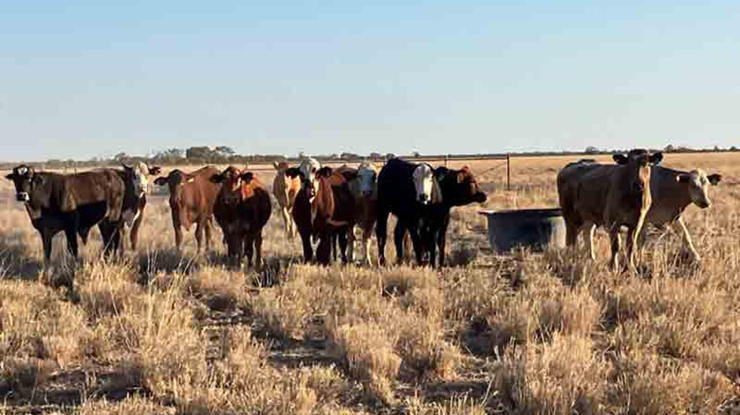From the wettest mountain peak to the driest desert dune, Australia boasts a spectacular diversity of frogs. Of our ~240 species, some 93 per cent are found only here. Through our network of over 30 large-scale wildlife sanctuaries in remote and iconic regions, AWC protects nearly 60 per cent of Australia’s frog species. This includes many poorly known and threatened species, whose conservation is paramount given grim extinction forecasts. Read on to learn about three lesser-known frogs we’re working to build a secure future for.
The ‘not-so-common’ Common mist frog
 Pat Webster/AWC
Pat Webster/AWCMuted in colour but not in call, this rainforest-loving species keeps busy, sounding a nasal “wreek wreek wreek” over rushing waters from . Though adults prefer to stay out of rapids – perching on vegetation, rocks, logs, and roots along streams – . They have muscular tails and flat bodies to aid in swimming against the current, and large mouthparts they use to cling to rocks. This endangered species is a habitat specialist, meaning it evolved to live in rainforests from sea level up to mountainous elevations of 1200 meters. Since 1990, however, the deadly Chytrid fungus has , leaving it now . The species’ total habitat has shrunk to around 6,000 square kilometres, making AWC’s Brooklyn Wildlife Sanctuary a crucial stronghold for it.
This Far North Queensland sanctuary supports a greater diversity of wildlife than any other AWC property, including one fifth of Australia’s frog species. In recent years, . These and many of the species found in Brooklyn’s mountainous east were severely affected by Chytrid elsewhere, due to their small distributions and elevational ranges.
In future, we hope to implement more targeted acoustic monitoring to help track species which are rarely seen without heavy and sustained rainfall events, but for now, the continued presence of these frogs on Brooklyn is a beacon of hope. It highlights not only the immense biodiversity significance of the sanctuary, but also the importance of effective conservation management and science-led habitat protection.
Miniature yet marvellous – the Magnificent broodfrog
 Pat Webster
Pat WebsterHalf the weight of a five-cent coin and only three centimetres long, what this species lacks in size it makes up for in charm. With a name and pattern that seem to have been conjured by a magician, the Magnificent broodfrog is adorned with a fire orange arrow on its back, and swirling periwinkle inkblots on its underside. These marbled splotches are like fingerprints in that they can be used by our scientists to identify specific individuals. through ‘call-and-response,’ croaking in reply to any sounds made during surveys. Despite the species’ memorable traits, it is one of Australia’s least understood amphibians, having only been formally described in 1994.
Known threats to the species include habitat loss and degradation through grazing, changed fire regimes, and road and infrastructure development. Trampling by feral herbivores damages the seepage areas crucial for their breeding, while road development alters water quality, affecting the habitats the frogs rely on. In 2014, AWC ecologists confirmed their presence at Mount Zero-Taravale Wildlife Sanctuary for the first time, an encouraging discovery as this sanctuary is protected from development and managed for cattle and fire control.
In 2021, targeted acoustic surveys at Mount Zero-Taravale doubled the number of known sites from six to twelve, . AWC’s ecological burn and feral herbivore management programs are directly supporting the preservation of this vulnerable species on sanctuary.
Tanami toadlet… taped!
 Tim Henderson/AWC
Tim Henderson/AWCLike the Magnificent broodfrog, the desert-dwelling Tanami toadlet is tiny, only recently known to science and greatly under-documented. Senior Science Communicator Joey Clarke notes that there hasn’t been as much scientific attention paid to frogs in Australia’s arid zone, partly because “their lifestyles typically involve very long periods where they are either underground or hiding out in little pockets of moisture in between rainfall events.” When it does rain, researchers need to be in the right place at the right time: “This species is found in desert parts of central and Western Australia, places with very low population density which become inaccessible after heavy rain.”
Fortunately, our dedicated team living on sanctuary at Newhaven is well-positioned to observe the effects of rainfall booms. This year, staff at Newhaven took advantage of the ephemeral lakes that had formed after a heavy rainfall event, .
Dr Tim Henderson, AWC Wildlife Ecologist and recorder of the call said, “The calls were really distinctive, unlike any of the other species that we find out here regularly. It’s not often that you get to document something like this for science for the first time.”
The call was recorded using , a free app developed by the Australian Museum to help citizen scientists identify and formally log the presence of frogs across Australia.
Dr Jodi Rowley, Lead Scientist of FrogID and Curator of Amphibians at the Australian Museum, said she was very excited to confirm the toadlet’s call.
“It’s taken 43 years since we first recognized this species for someone to record its call – that’s pretty amazing! There’s still so much to discover about Australian amphibians, and this recording will make it easier for other people to detect Tanami Toadlets in the future.”
Australia’s biggest frog count takes place from November 8th to 17th. With a few simple recordings, you can provide invaluable data on frog distributions over time, helping herpetologists to understand how frogs and their ecosystems are responding to a changing planet. to contribute to their conservation, today and into the future.







